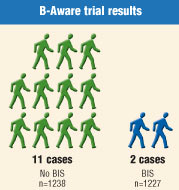Anesthesia monitoring technology may reduce intraop awareness
The complication is rare, but bispectral index monitoring has reduced intraoperative awareness incidence by 82% in high-risk patients.
Preliminary results of two studies of intraoperative awareness have led the Food and Drug Administration to broaden its approval of a device that may help anesthesiologists better monitor patients so they do not wake up during surgery.
Bispectral (BIS) index monitoring, which was used in the Australian Bispectral Index Monitoring to Prevent Awareness during Anesthesia (B-Aware) trial considered by FDA officials, converts a patient’s electroencephalogram to a displayed number corresponding to brain activity. A high number means increased activity and a low one signals less activity, such as when the patient is “asleep.” The technology was introduced in 1996 by Aspect Medical Systems Inc. of Newton, Mass.
While the issue of awareness is important, physicians should be wary of treating a patient strictly based on a monitor reading and not key vital signs like heart rate and blood pressure, said John F. Dombrowski, MD, district director of the American Society of Anesthesiologists (ASA).
“Any tool is good, but you especially need the anesthesiologist, the person in the OR who specializes in bringing in all these areas of information,” he told Orthopedics Today in a phone interview.
Awareness documented
The Awareness Incidence and Monitoring (AIM) trial involved nearly 20,000 surgical patients to document awareness. There was a recall rate of one to two cases per 1000 U.S. patients receiving general anesthesia, according to a press release from Aspect Medical. The firm sponsored both trials.
“While awareness is relatively rare, the incidence we found in the AIM trial takes on new meaning when you consider that more than 20 million anesthesia cases are performed annually in the United States. This translates to approximately 100 patients experiencing awareness with recall every operating weekday,” Peter Sebel, MD, professor of anesthesiology at Emory University School of Medicine, said in the release. He presented results at the ASA annual meeting.
Lead researcher Paul Myles, MD, presented results of the B-Aware trial conducted in Australia, which analyzed use of BIS monitoring in 2500 patients at high risk of experiencing awareness. Researchers found awareness recall decreased 82% with use of BIS-guided anesthesia.
Monitoring results
|
|
Source: Aspect Medical |
Results of the Swedish Awareness Follow-Up Evaluation (SAFE-2), which were presented at the International Anesthesia Research Society meeting, showed that routine BIS monitoring reduced awareness incidence by 78% compared to controls. The study involved 7811 patients with general anesthesia and 5057 patients with BIS-guided anesthesia who were consecutively treated.
“The findings of the B-Aware and SAFE-2 trails are consistent and significant in that, for the first time, we have scientific evidence that use of BIS technology can help us ensure that our patients don’t wake up while under anesthesia,” Myles said in a release.
Waking up under anesthesia is rare, Dombrowski agreed, citing a major study published over a decade ago that showed the incidence was one-fifth of 1%. “That is very low. Certainly when this happens, it’s a tragic event.”
To help reduce the incidence of awareness, physicians should know who is at increased risk, such as trauma and cardiac patients. “We are always interested in making our practice safer and better, but nothing replaces the anesthesiologist,” Dombrowski said.
Before undergoing any orthopedic procedure, patients should have all their questions answered by the surgeon and the anesthesiologist, he said.

